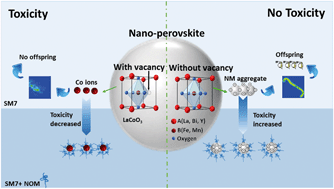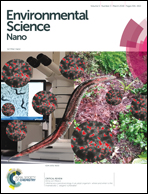Comparative assessment of the chronic effects of five nano-perovskites on Daphnia magna: a structure-based toxicity mechanism†
Abstract
Perovskite nanomaterials (PNMs) have significant application potential, however the fate and potential ecological effects of PNMs released into aquatic environments are completely unknown. To investigate this, five representative PNMs (LaFeO3, YFeO3, BiFeO3, LaMnO3 and LaCoO3) were synthesized and their acute and chronic toxicities to the aquatic invertebrate Daphnia magna were assessed in the absence and presence of gum arabic (GA). Various methods were used to characterize both PNMs and PNM suspensions, to clarify the toxicity mechanism. Results show that in raw PNM suspensions, LaCoO3 significantly inhibited daphnid growth and induced 100% mortality after 21 d. In contrast, no detrimental effects were observed in D. magna exposed to the other PNMs. Synchrotron radiation X-ray fluorescence (SR-XRF) confirmed the distinctive distribution of LaCoO3, compared with the other PNMs, with oxygen vacancies playing a significant role in the toxicity of LaCoO3. In the presence of GA, toxicity was altered in all PNMs except YFeO3, due to PNM transformation. This study provides a preliminary approach for investigation of the environmental impact of PNM release.



 Please wait while we load your content...
Please wait while we load your content...